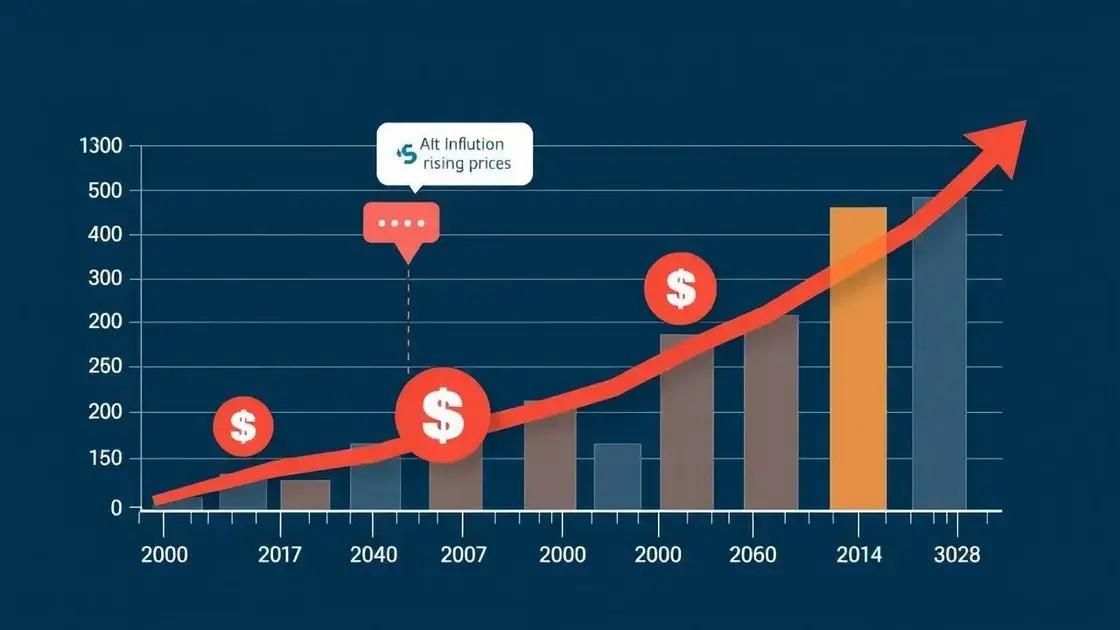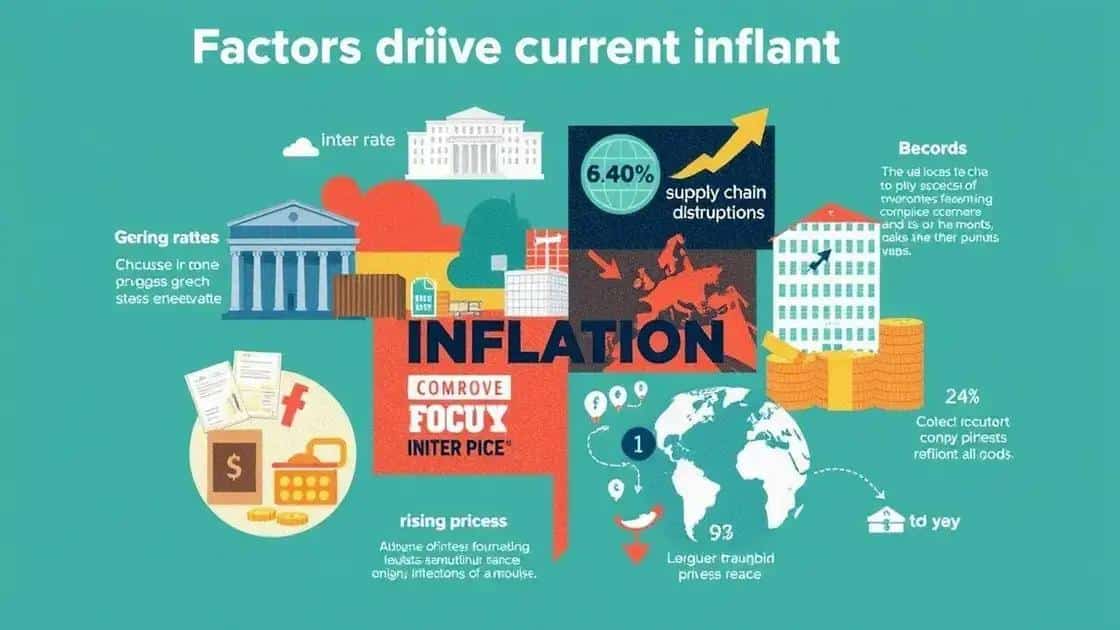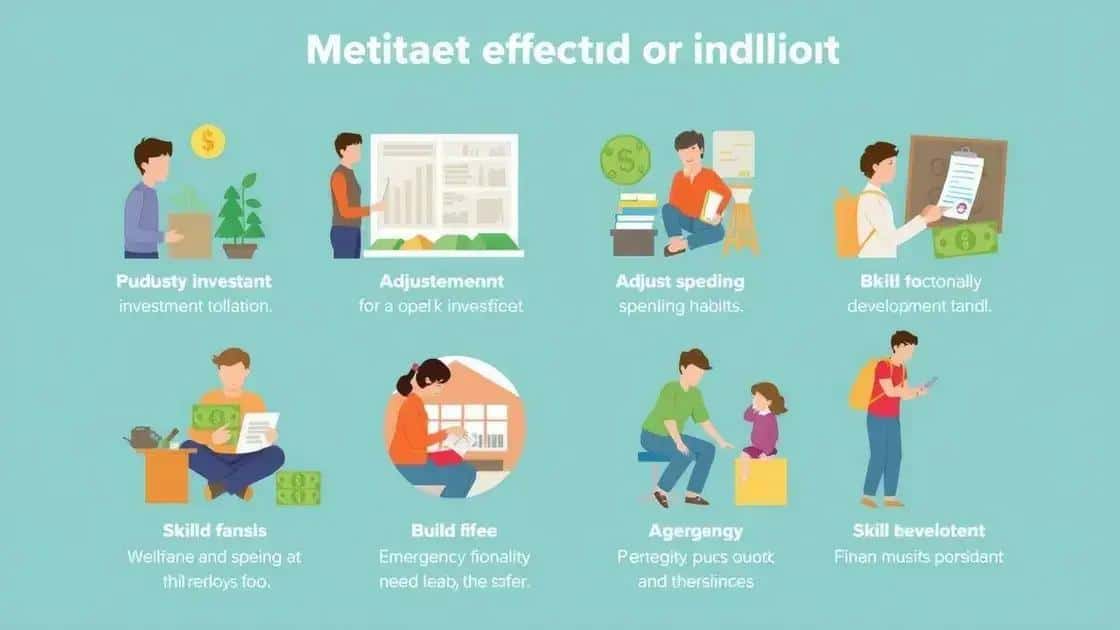Inflation trends: how they affect your finances

Anúncios
Understanding inflation trends helps consumers adjust their spending, prioritize essentials, and adopt strategies like diversifying investments to protect against rising costs effectively.
Inflation trends are more than just numbers; they influence our daily spending and savings decisions. Have you noticed higher prices lately? Let’s delve into what’s driving these changes and how you can adapt.
Anúncios
Understanding inflation trends over the years
Understanding inflation trends over the years provides essential insights into the economy. By analyzing past patterns, we can better anticipate future changes. Let’s explore some key elements that shape these trends.
The Historical Perspective
Over the decades, inflation has fluctuated significantly. Notably, the inflation rates during the 1970s were historically high. Factors influencing these changes include global economic events, government policies, and shifts in consumer behavior. Understanding these elements can help us interpret why inflation behaves the way it does.
Key Influencers of Inflation
Several factors contribute to rising inflation:
Anúncios
- Monetary Policy: Central banks play a crucial role by adjusting interest rates.
- Supply Chain Disruptions: Events, like natural disasters or pandemics, can lead to shortages.
- Consumer Demand: Increased demand can push prices higher, especially if supply doesn’t keep up.
- Global Events: Economic crises in other countries can ripple through to the local economy.
As consumers, it’s essential to recognize how these factors contribute to the costs of everyday goods. For instance, when demand spikes, prices often follow. This can lead to greater expenses for essentials like food and fuel.
Another significant aspect is the role of inflation expectations. If businesses expect prices to rise, they may increase their prices preemptively. This self-fulfilling prophecy can create a cycle that perpetuates inflation, making it vital to monitor these trends closely.
As we reflect on inflation trends, it’s clear that staying informed can empower consumers to make better financial decisions. By understanding the influences and patterns of the past, you can navigate the future with a more informed perspective.
Key factors driving current inflation

Many key factors drive current inflation, shaping the economic landscape that affects our daily lives. By understanding these elements, we can navigate the complexities of today’s financial environment more effectively.
Monetary Policy and Interest Rates
The actions of central banks play a significant role in influencing inflation. When interest rates are low, borrowing costs decrease. This often leads to increased spending and investment, which can push prices higher.
Supply Chain Challenges
Recent global events have highlighted supply chain vulnerabilities. Disruptions from natural disasters, geopolitical tensions, and pandemics can lead to shortages of essential goods. Here are some challenges:
- Delays in shipping and transportation
- Increased production costs
- Higher demand than supply
- Labor shortages in key industries
These issues affect the availability of products, causing prices to rise as consumers compete for the remaining goods.
Additionally, consumer demand plays a critical role. When people feel optimistic about their financial situation, they tend to spend more. This increased demand can exacerbate inflation, especially if businesses struggle to keep up with production.
Global events can also sway current inflation. For instance, international crises can lead to rising oil prices. As energy costs surge, the prices of goods and services across various sectors typically follow suit. Understanding these dynamics helps consumers prepare for potential cost increases in their everyday purchases.
Impact of inflation on consumer behavior
The impact of inflation on consumer behavior is significant and can change how people spend their money. As prices rise, individuals often adjust their purchasing habits to accommodate higher costs.
Shifts in Spending Habits
When inflation occurs, many consumers become more cautious with their spending. They may prioritize essential items over luxury goods. This shift is crucial for businesses to understand, as they may need to adapt their strategies.
Increased Price Sensitivity
With rising prices, consumers tend to become more price-sensitive. They look for deals and discounts more actively. Here are some common behaviors:
- Comparing prices across different stores
- Using coupons and promotional offers
- Switching to generic or store-brand products
- Postponing non-essential purchases
These actions can lead to decreased sales for brands that do not offer competitive pricing or value.
Inflation can also lead consumers to rethink their financial strategies. Many will start saving more to prepare for future price increases. This behavior reflects a shift in confidence and expectations about the economy. Higher inflation rates can cause individuals to worry about long-term financial stability.
As consumers adapt to inflation, financial education becomes critical. Understanding how inflation impacts savings and investments can help individuals navigate their financial future. Making informed decisions is key to protecting purchasing power during inflationary periods.
Strategies to mitigate inflation effects

There are several effective strategies to mitigate the effects of inflation. Understanding these techniques can help individuals and families protect their finances during challenging economic periods.
Diversifying Investments
One key strategy is to diversify investments. By spreading money across various assets, such as stocks, bonds, and real estate, individuals can reduce risk. This approach helps ensure that even if one sector declines, others may perform better.
Adjusting Spending Habits
Another practical approach is adjusting spending habits. Here are some tips:
- Focus on essential purchases rather than luxury items.
- Take advantage of sales and discounts whenever possible.
- Buy in bulk to save money on frequently used items.
- Consider substituting high-priced goods with less expensive alternatives.
Such changes can help maintain a balanced budget without sacrificing necessary goods.
Additionally, building an emergency fund is crucial. Having savings set aside can provide security in case of unexpected expenses or job loss. This fund can help families manage their finances better during inflationary times.
Investing in skills and education is another valuable strategy. By enhancing qualifications, individuals can improve their job prospects and potentially earn more. This can offset rising living costs and contribute to financial stability.
Lastly, staying informed about economic trends and making proactive decisions is essential. Understanding when to make financial adjustments can greatly help in maintaining personal finance health, especially during inflationary periods.
FAQ – Frequently Asked Questions about Inflation and Financial Strategies
What are some common strategies to mitigate the effects of inflation?
Common strategies include diversifying investments, adjusting spending habits, building an emergency fund, and staying informed about economic trends.
How does inflation affect consumer spending?
Inflation typically makes consumers more price-sensitive, leading them to prioritize essential purchases and seek discounts.
Why is having an emergency fund important during inflation?
An emergency fund provides financial security during unexpected situations, helping individuals manage rising costs without falling into debt.
What role does education play in mitigating inflation’s impact?
Investing in education and skills can enhance job prospects and potential earnings, helping consumers offset the effects of rising prices.






